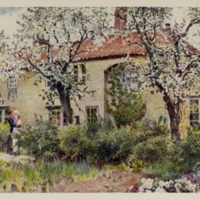Description
Once more following on the footsteps of William Henry Bartlett, Marcus Huish visits in 1907 the remains of Scooby Manor, the home of William Brewster. Since Bartlett’s tour in the 1850s, the site had become more established as a point of interest on the Mayflower tourist map, with a brass plate commemorating the link to the Pilgrim fathers placed on the nearby farm, which bears the name of the manor house. Elizabeth Chettle provides a water-colour of manor-house farm. As Huish says:
"All that now remains of the "great Manor Place" are indications of fish-ponds and moat. A manor-house farm alone retains the name, but it still belongs to the Archbishop of York. Bartlett when he visited it in 1852 found fragments of richly carved woodwork propping up the roof of a cowhouse, and it is believed that it was here that the little congregation hereafter mentioned met for worship, practically under the Archbishop's roof. On the west side of the house is affixed a brass plate, which records that
This tablet was erected by the Pilgrim Society of Plymouth, Massachusetts, United States of America, to mark the site of the ancient Manor House where lived William Brewster from 1588 to 1608, and where he organised the Pilgrim Church, of which he became a ruling Elder, and with which in 1608 he removed to Amsterdam, in 1609 to Ley den, and in 1620 to Plymouth, where he died, April i6th, 1644.
So lately as 1860 a mulberry-tree, recorded to have been planted by Cardinal Wolsey, showed 'an old and tottering stem,' but this has disappeared."

